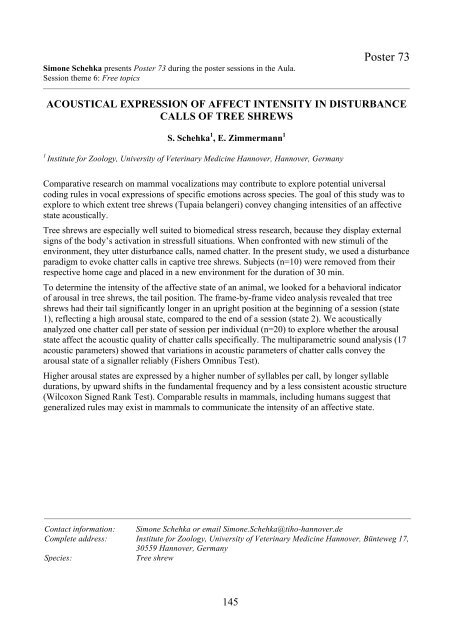Acknowledgements Book of abstracts - Publicaties - Vlaanderen.be
Acknowledgements Book of abstracts - Publicaties - Vlaanderen.be
Acknowledgements Book of abstracts - Publicaties - Vlaanderen.be
You also want an ePaper? Increase the reach of your titles
YUMPU automatically turns print PDFs into web optimized ePapers that Google loves.
Simone Schehka presents Poster 73 during the poster sessions in the Aula.<br />
Session theme 6: Free topics<br />
145<br />
Poster 73<br />
ACOUSTICAL EXPRESSION OF AFFECT INTENSITY IN DISTURBANCE<br />
CALLS OF TREE SHREWS<br />
S. Schehka 1 , E. Zimmermann 1<br />
1 Institute for Zoology, University <strong>of</strong> Veterinary Medicine Hannover, Hannover, Germany<br />
Comparative research on mammal vocalizations may contribute to explore potential universal<br />
coding rules in vocal expressions <strong>of</strong> specific emotions across species. The goal <strong>of</strong> this study was to<br />
explore to which extent tree shrews (Tupaia <strong>be</strong>langeri) convey changing intensities <strong>of</strong> an affective<br />
state acoustically.<br />
Tree shrews are especially well suited to biomedical stress research, <strong>be</strong>cause they display external<br />
signs <strong>of</strong> the body’s activation in stressfull situations. When confronted with new stimuli <strong>of</strong> the<br />
environment, they utter disturbance calls, named chatter. In the present study, we used a disturbance<br />
paradigm to evoke chatter calls in captive tree shrews. Subjects (n=10) were removed from their<br />
respective home cage and placed in a new environment for the duration <strong>of</strong> 30 min.<br />
To determine the intensity <strong>of</strong> the affective state <strong>of</strong> an animal, we looked for a <strong>be</strong>havioral indicator<br />
<strong>of</strong> arousal in tree shrews, the tail position. The frame-by-frame video analysis revealed that tree<br />
shrews had their tail significantly longer in an upright position at the <strong>be</strong>ginning <strong>of</strong> a session (state<br />
1), reflecting a high arousal state, compared to the end <strong>of</strong> a session (state 2). We acoustically<br />
analyzed one chatter call per state <strong>of</strong> session per individual (n=20) to explore whether the arousal<br />
state affect the acoustic quality <strong>of</strong> chatter calls specifically. The multiparametric sound analysis (17<br />
acoustic parameters) showed that variations in acoustic parameters <strong>of</strong> chatter calls convey the<br />
arousal state <strong>of</strong> a signaller reliably (Fishers Omnibus Test).<br />
Higher arousal states are expressed by a higher num<strong>be</strong>r <strong>of</strong> syllables per call, by longer syllable<br />
durations, by upward shifts in the fundamental frequency and by a less consistent acoustic structure<br />
(Wilcoxon Signed Rank Test). Comparable results in mammals, including humans suggest that<br />
generalized rules may exist in mammals to communicate the intensity <strong>of</strong> an affective state.<br />
Contact information: Simone Schehka or email Simone.Schehka@tiho-hannover.de<br />
Complete address: Institute for Zoology, University <strong>of</strong> Veterinary Medicine Hannover, Bünteweg 17,<br />
30559 Hannover, Germany<br />
Species: Tree shrew
















